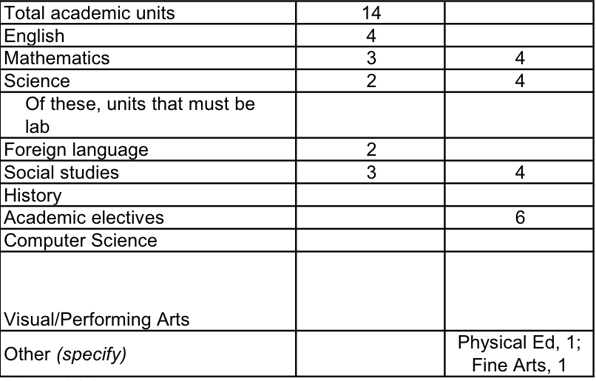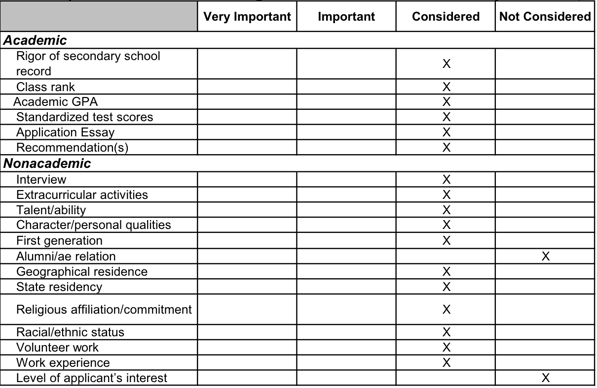University of Texas at Austin Admissions Profile

Introduction
Welcome to our comprehensive guide on the University of Texas at Austin admissions profile. If you're considering applying to UT Austin, this article will provide you with all the essential information you need to know. From admission requirements to the application process, scholarships, and campus life, we've got you covered. Let's dive in and explore what makes UT Austin such a prestigious institution.
UT Austin Admissions Profile
The University of Texas at Austin, often referred to as UT Austin or simply UT, is a renowned public research university located in Austin, Texas. Established in 1883, UT Austin is known for its academic excellence, diverse student body, and vibrant campus culture. With a wide range of academic programs and a commitment to innovation, UT Austin offers an exceptional educational experience.
Below are tables highlighting how UT Austin evaluates each applicant through information published in the Common Data Set, a resource that compiles a standardized list of data items provided by universities about their admissions profiles.
Distribution of high school units required and/or recommended
![]()

Relative importance of each of the following academic and nonacademic factors in your application

SAT and ACT Policies

Admissions Requirements
To gain admission to UT Austin, applicants must meet certain requirements. Here are the key factors considered during the admissions process:
-
Academic Achievement: UT Austin seeks students who have demonstrated academic excellence. Admissions officers review your high school coursework, grades, class rank, and the rigor of your curriculum. They look for students who have challenged themselves academically and have excelled in their studies.
-
Standardized Test Scores: While UT Austin takes a holistic approach to admissions, SAT or ACT scores play a role in the evaluation process. It's recommended that applicants aim for scores within or above the middle 50% range of admitted students. However, it's important to note that UT Austin has implemented a test-optional policy for the 2022-2023 and 2023-2024 admissions cycles.
-
Essays and Personal Statements: UT Austin requires applicants to submit essays and personal statements that provide insights into their character, experiences, and aspirations. These essays offer an opportunity to showcase your unique qualities, demonstrate your writing skills, and highlight your fit with UT Austin.
-
Letters of Recommendation: UT Austin typically requires one or two letters of recommendation. Select individuals who know you well academically or personally and can speak to your abilities, character, and potential for success at the university. Follow the instructions provided on the application for submitting letters of recommendation.
The Application Process
Applying to UT Austin involves several steps, and it's important to stay organized throughout the process. Let's walk through each stage of the application process:
1. ApplyTexas Application
UT Austin accepts the ApplyTexas Application. Complete the application form accurately, including personal information, academic history, extracurricular involvement, and essays. Pay attention to the specific requirements and prompts within the application.
2. Longhorns Status Check
After submitting your application, you will receive login information for the Longhorns Status Check portal. This portal allows you to track the status of your application, view any missing documents, and receive updates regarding your admission decision.
3. Essays and Short Answers
The University of Texas at Austin (UT Austin) views the supplemental essays as an integral part of the admissions process. These essays provide prospective students with an opportunity to showcase their personality, experiences, goals, and fit for UT Austin beyond what can be captured in grades and test scores alone.
For all applicants, UT Austin requires submission of the ApplyTexas or Coalition Application, both of which have their own set of essay prompts. Furthermore, UT Austin requires one additional supplemental essay known as the "Short Answer." Depending on the applicant's chosen major or if they're applying to honors programs, additional essays may be required.
The primary application (either ApplyTexas or Coalition) includes an essay of approximately 500-700 words. The prompts typically ask students to share a personal story that has shaped their life and aspirations. This essay provides an opportunity for applicants to share a unique aspect of their lives, demonstrating their personal values, resilience, or growth over time.
The required Short Answer for UT Austin is usually around 250-300 words. This prompt asks why the applicant is interested in their chosen major at UT Austin. This is the applicant's opportunity to demonstrate a deep understanding of their chosen field and how UT Austin's specific program aligns with their academic and career goals. Successful responses often highlight the applicant's previous experiences in the field and specific aspects of UT Austin's program that they're excited to engage with.
For students applying to some programs or honors colleges at UT Austin, there may be additional required essays. These prompts usually center around the applicant's interest in the program, their future goals, and any relevant experiences they've had in the field. The word count for these additional essays typically ranges from 250-500 words.
In crafting these essays, students should strive for clarity, authenticity, and reflection. It's important to not just describe experiences, but also to explain their impact and how they've shaped the applicant as an individual. Each essay should provide a different perspective of the applicant, ultimately creating a well-rounded view of who they are and what they could bring to the UT Austin community.
Sample Essays
Prompt: Using a favorite quotation from an essay or book you have read in the last three years as a starting point, tell us about an event or experience that helped you define one of your values or changed how you approach the world. Please write the quotation, title and author at the beginning of your essay (prompt from the 2020-2021 cycle).
Answer:
“Fortunately, among these people a man was judged according to his worth and not according to the worth of his father.”
– Chinua Achebe, Things Fall Apart
Like most children, I aspired to my father.
I saw my dad as an image of whom I wanted to be. Charismatic, genuine, respected among his peers – he embodied the qualities I saw essential to being a successful person.
The most appealing to me, however, was my father’s medical background. As the first person to attend university in our extended family, he had always been revered for his accomplishment of becoming a doctor.
As a direct consequence, biology was a keen passion during my childhood. I remember how each evening, as I was being tucked into bed, I would unload an avalanche of questions on my dad, many of them amusingly simple such as: If my body is 70% water, why don’t I have water spilling out of my finger every time I get a papercut? In school, I’d stay after class to probe my teachers about the topics I had read of but did not yet comprehend. And anytime I was asked what I wanted to be when I grew up, I, without a whiff of doubt, bolted out I was going to be a doctor.
However, as I got older, I developed new interests – in particular, social science and leadership – which did not always align with my childhood goals of medicine and biology.
With this dichotomy in my mind, I decided to spend my sophomore summer volunteering at a hospital.
Once there, it suddenly dawned on me that, for my entire life, I had viewed being a doctor through rose-tinted glasses since the reality of being a medical professional differed wildly from my perceptions. The dozens of biology textbooks I had read had not prepared me for a single drop of blood, as seeing just one could send me into an exhausting realm of dizziness. With every additional day of volunteering, it became painfully clear – I could not follow in my father’s footsteps.
Disappointed, I began contemplating what made my experience in the hospital so bad and if anything could be done to improve people’s – whether patients’, doctors’, or volunteers’ like myself – experience. Then, a light-bulb switched on: what if I could improve the look of the hospital? As it stood, the hospital was incredibly run-down and inspired depression rather than hope.
With a goal to improve the hospital’s appearance and thus create a friendlier environment for the people inside, I started the Better Setting – Better Getting project, which was going to decorate the hospital with photographs of nature. Having done so, there was a question of financing ー with the hospital administration over-budget, I had to source the funding entirely from the private sector. It was challenging but, a few dozen cold-calls and a handful of live-pitches later, I found a corporate partner that recognised my vision. Finally, I was ready to make my goal a reality. Legal roadblocks and printing nuances still stood in the way, but, with the enthusiastic support of the hospital community, I was able to navigate my way through. Today, dozens of wall-sized nature photos emit joy and hope into the halls of the hospital.
My hospital volunteering, which had begun with heartbreak and disillusion, turned out to be a defining experience of self-discovery. It helped me close my chapter on medicine, a chapter I had so often doubted, and helped me validate my passion for leadership; it allowed me to operate free of doubt, knowing that I don’t have to follow my father’s footsteps. Above all, it made me realise that, although I would never be a doctor, I could nonetheless have a positive impact on society in my very own way.
Prompt: Why are you interested in the major you indicated as your first-choice major?
Answer: I woke up. The curtains filtered the sun rays, hitting my face directly. I got up, looked from the bathroom to the kitchen, but my dad wasn’t there. I plopped on the couch, then the door opened. My dad walked in, clutching a brown paper bag with ninety-nine cent breakfast tacos. After eating, we drove to a customer’s house. He sat me in a chair, lifted the floorboard, and crawled under the house to fix the pipes. As he emerged, he talked, but my mind drifted to the weight of the eleven-millimeter hex wrench in my hand. My interest in mechanical engineering originates from my dad, who was a plumber. When I was fifteen, my dad passed away from cancer that constricted his throat. Holding his calloused hand on his deathbed, I wanted to prevent the suffering of others from cancer. Two years later, when I was given a topic of choice for my chemistry research paper, I stumbled upon an article about gold nanoparticles used for HIV treatment. I decided to steer the topic of gold nanoparticles used for cancer treatment instead, entering the field of nanotechnology. After reading numerous articles and watching college lectures on YouTube, I was utterly captivated by topics like using miniscule devices to induce hyperthermia as a safe method of cancer treatment. Nanotechnology is multi-disciplinary, reinforcing my interest in pursuing mechanical engineering as a gateway to participate in nanoscience and nanotechnology research at the University of Texas at Austin. I have learned that nanotechnology is not limited to stories like mine, but to other issues such as sustainable energy and water development that I hope to work towards. It is important for me to continue helping others without forfeiting my interest in nanotechnology, working in collaboration with both engineering and the medical field.
4. Letters of Recommendation
UT Austin typically requires one or two letters of recommendation. Select recommenders who know you well academically or personally and can speak to your abilities, character, and potential for success at the university. Follow the instructions provided on the application for submitting letters of recommendation.
5. Application Fee or Fee Waiver
There is an application fee to submit your application to UT Austin. However, fee waivers are available for eligible students who demonstrate financial need. Review the fee waiver information on the UT Austin admissions website for specific details and instructions.
6. Deadlines
When applying to the University of Texas at Austin (UT Austin), it's crucial to be aware of and meet all application deadlines. UT Austin enforces these dates strictly, and failing to submit all necessary application materials on time could result in an applicant's disqualification from consideration.
UT Austin offers one primary application deadline for first-year students, although some programs may have different deadlines. Here are the key dates:
-
Priority Deadline: UT Austin uses a priority deadline system for its applicants, meaning all materials must be submitted by November 1. By meeting this deadline, students receive priority consideration for admission and scholarships. Applicants can expect to receive an admission decision by February 1.
-
Regular Deadline: The regular deadline for UT Austin falls on December 1. While students applying by this date will still be considered for admission, they might not be given priority for scholarships. Admission decisions for regular applications are generally released by March 1.
For transfer students, the application deadline for the Fall semester typically falls in mid-March, while the Spring semester application deadline is usually in October of the previous year.
International students, whether first-year or transfer, are advised to adhere to the same deadlines as domestic students. However, it's recommended they submit their applications as early as possible to allow for any extra processing time that may be needed due to visa and other logistical requirements.
Additionally, it's important to be aware of other related deadlines. For instance, the deadline for submitting the Free Application for Federal Student Aid (FAFSA) and scholarship applications typically falls in January.
It's always recommended that prospective students verify all dates on the official UT Austin admissions website, as exact deadlines may vary slightly from year to year.
In summary, staying aware of and meeting all application deadlines is a crucial step in the admissions process at the University of Texas at Austin. This diligence ensures that your application gets the timely and thorough review it deserves.
Scholarships and Financial Aid
UT Austin is committed to providing access to education and offers various scholarships and financial aid options to assist students. Here are a few examples:
-
TEXAS Grant: The TEXAS Grant is a need-based grant program specifically for Texas residents. It provides financial assistance to eligible students to help cover tuition and fees.
-
UT Austin Scholarships: UT Austin offers a range of scholarships for incoming students. These scholarships are awarded based on academic achievements, leadership qualities, or other outstanding accomplishments. The Office of Scholarships and Financial Aid can provide more information on available scholarships.
-
Financial Aid Programs: UT Austin provides various financial aid programs, including grants, work-study opportunities, and low-interest loans. By submitting the Free Application for Federal Student Aid (FAFSA), students can be considered for these financial aid programs.
Campus Life and Resources
UT Austin offers a vibrant campus life with a wide range of resources and opportunities for students to engage in. Here are some highlights:
-
Academic Excellence: UT Austin is known for its academic rigor and offers over 170 undergraduate programs across various disciplines, including arts and humanities, sciences, business, engineering, and more. With world-class faculty and state-of-the-art facilities, students have the opportunity to engage in rigorous coursework and pursue their academic passions.
-
Research Opportunities: UT Austin is a leading research institution, providing numerous research opportunities for undergraduate students. Through research programs, internships, and collaborations with faculty, students can engage in cutting-edge research and contribute to advancements in their fields of interest.
-
Student Organizations and Activities: UT Austin offers a diverse range of student organizations and extracurricular activities. With over 1,200 registered student organizations, there are ample opportunities to explore your interests, develop leadership skills, and form meaningful connections with peers who share your passions.
-
Texas Athletics: UT Austin is home to a competitive athletic program known as the Texas Longhorns. Whether you're a participant or a fan, you can enjoy cheering on the teams in various sports, including football, basketball, soccer, and more.

Frequently Asked Questions
What is the acceptance rate at UT Austin?
The acceptance rate for UT Austin varies each year and depends on the applicant pool. It is generally competitive, with an average acceptance rate of around 32-33%.
Does UT Austin require interviews for admission?
What majors and programs are offered at UT Austin?
UT Austin offers a wide range of undergraduate majors and programs across various fields, including liberal arts, sciences, engineering, business, fine arts, and more. Explore the UT Austin website for a comprehensive list of available majors.
Conclusion
The University of Texas at Austin offers an exceptional educational experience with its academic excellence, diverse opportunities, and vibrant campus community. By understanding the UT Austin admissions profile, you can approach the application process with confidence. Best of luck as you embark on this exciting journey towards an exceptional education at UT Austin.
